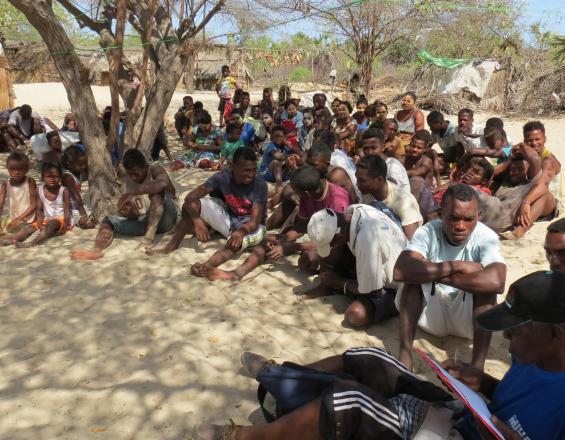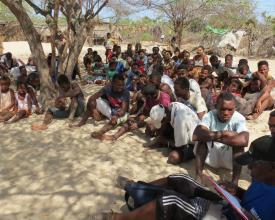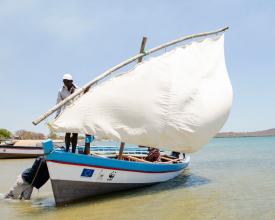
Gestion pionnière d'une AMP adaptée au changement climatique à Madagascar
Solution complète

Réunion communautaire à Nosy Hara
WWF
Les menaces que le changement climatique fait peser sur les écosystèmes et la biodiversité des zones protégées et sur les populations humaines sont de plus en plus nombreuses. Les aires protégées peuvent également être un outil efficace pour renforcer leur résilience. Cette solution consiste donc à construire des aires protégées résilientes à Nosy Hara qui peuvent aider à garantir l'utilisation à long terme des services écosystémiques par les communautés locales dans un climat changeant, tout en améliorant la protection de la riche vie marine de la zone en prenant en compte le changement climatique dans sa gestion.
Dernière modification 28 Mar 2019
8131 Vues
Contexte
Défis à relever
Manque de connaissances sur le changement climatique et absence de données climatiques locales à long terme Manque de connaissances sur le changement climatique (CC) parmi les gestionnaires d'AMP ; manque de prise en compte des impacts du CC dans la gestion des AMP, exposant potentiellement des zones très résilientes à une utilisation néfaste en raison d'une protection limitée, rendant les écosystèmes, les espèces et les communautés locales plus vulnérables ; absence de données climatiques locales à long terme ; forte dépendance de la population locale à l'égard de la pêche à petite échelle et de l'agriculture traditionnelle.
Emplacement
Madagascar
Afrique de l'Est et du Sud
Traiter
Résumé du processus
Le renforcement des capacités donne une orientation claire sur le lien entre le travail habituel et l'adaptation et sur la façon dont les changements climatiques pourraient exacerber les menaces existantes. En particulier, la formation sur les changements climatiques permet de comprendre le concept clé de l'évaluation de la vulnérabilité, qui est à la base de la révision du plan de gestion. L'évaluation de la vulnérabilité est principalement menée par des experts avec le soutien des gestionnaires d'AMP. Ces derniers pourraient être en mesure d'apporter une contribution précieuse à ce processus grâce aux connaissances qu'ils ont acquises lors de la session de renforcement des capacités. L'analyse quantitative sera combinée avec les connaissances traditionnelles (recueillies grâce à la boîte à outils sur les témoins climatiques) afin de combler les lacunes en matière de données. Les résultats de l'AV permettront de réviser l'état de conservation et le niveau des menaces, ainsi que d'identifier les zones les plus résilientes ou les plus vulnérables qui nécessitent une plus grande attention. L'option d'adaptation est définie en fonction des résultats de l'AV. Elle alimentera la stratégie du plan de gestion qui peut traiter à la fois les impacts climatiques et les impacts induits par l'homme. Une bonne compréhension des concepts clés du CC facilitera l'identification de ces options d'adaptation. Sur la base de toutes les étapes ci-dessus, un plan de gestion climato-intelligent est développé et permettra de construire une AMP résiliente.
Blocs de construction
Renforcement des capacités en matière de changement climatique pour les gestionnaires d'AMP
Le WWF a renforcé les capacités des gestionnaires d'AMP de Madagascar National Parks en matière de changement climatique, dans le but de mettre à jour leurs outils de gestion en améliorant les connaissances sur les concepts clés du changement climatique et ses impacts potentiels sur les zones côtières et marines. Les gestionnaires d'AMP ont également été formés à la réalisation d'études sur la résilience des récifs afin de quantifier les indicateurs de base de résistance et de résilience pour l'évaluation des récifs coralliens. Cela permet notamment de surveiller les effets de l'augmentation de la température de la mer sur les récifs coralliens, les incidences du blanchiment des coraux et les effets du changement climatique sur la pêche artisanale.
Facteurs favorables
Des outils de formation utiles et compréhensibles par différentes cibles, y compris les communautés locales. Des exemples pratiques qui montrent le lien entre le travail habituel et l'adaptation. Des visites d'échange sur le terrain qui aident les gestionnaires d'AMP et les communautés locales à tirer parti d'autres expériences d'adaptation.
Leçon apprise
Toutes les initiatives d'adaptation au changement climatique (ACC) devraient commencer par un renforcement des capacités afin d'assurer une compréhension commune des concepts du changement climatique par les gestionnaires d'AMP, leur permettant d'appréhender ses impacts directs sur la biodiversité et les moyens de subsistance, ainsi que son interaction avec les menaces existantes. Le renforcement des capacités permet de mettre en place des outils de gestion et une stratégie appropriés qui aident à construire une AMP résiliente dans un climat changeant. Des outils de formation similaires devraient être développés pour les communautés locales, car leur implication dans la gestion et le suivi de l'AMP est essentielle.
Boîte à outils de la communauté des témoins climatiques
La boîte à outils communautaire participative Climate Witness permet de documenter les impacts locaux du changement climatique et de concevoir des mesures d'adaptation appropriées pour les communautés. Elle comprend plusieurs exercices participatifs, tels que la cartographie, le calendrier saisonnier ou l'inventaire des espèces. La communauté est invitée à identifier les changements survenus au cours des dernières années. La discussion permettra d'identifier les problèmes clés avec leurs causes principales et les options d'adaptation. Le résultat final est un plan d'action communautaire décrivant les options d'adaptation prioritaires.
Facteurs favorables
Un mélange de jeunes et de personnes âgées de chaque catégorie principale de villageois (pêcheurs, agriculteurs, etc.) ainsi que des villageois non actifs - Au moins trois jours de réunion/atelier de village pour discuter de tous les outils décrits dans la boîte à outils. Discussion avec un groupe de personnes âgées du village qui ont une bonne connaissance des événements passés à long terme et des impacts associés. Niveau minimum de compréhension du changement climatique de la part de l'enquêteur (pas nécessairement pour les communautés locales).
Leçon apprise
S'appuyer sur les connaissances des communautés permet de remédier au manque de données climatiques à long terme et à leur impact sur les moyens de subsistance et les ressources naturelles, en particulier dans un pays comme Madagascar où ce type de données fait défaut au niveau local. Il sert également de guide et de complément à d'autres recherches quantitatives, en particulier les évaluations de la vulnérabilité socio-économique. Les résultats de l'utilisation de cet outil permettront d'ajuster les mesures d'adaptation déjà mises en œuvre par les communautés locales (qui sont parfois une mauvaise adaptation) ainsi que de commencer à mettre en œuvre des mesures d'adaptation préliminaires.
Évaluation de la vulnérabilité au changement climatique
Une évaluation de la vulnérabilité a été menée pour identifier les points chauds de la vulnérabilité au changement climatique et les options d'adaptation qui aident à renforcer et/ou à maintenir la résilience du site, en se concentrant sur les objectifs de conservation de l'AMP. Elles permettent de comprendre l'état des cibles bio-écologiques et sociales en ce qui concerne les impacts du changement climatique et donnent des conseils sur la manière d'accroître leur résilience. Elles ont été guidées par des processus multi-experts et multi-partenaires. Les résultats guideront la révision du plan de gestion existant.
Facteurs favorables
Processus multi-expert considérant les liens entre la conservation des AMP et les objectifs sociaux mais pas une analyse autonome - Adaptation de la méthodologie renommée au contexte local et particulièrement aux données disponibles - Implication d'une équipe SIG dans le processus d'AV considérant que le résultat final est une carte de vulnérabilité multi-cibles, un outil de décision clé pour les gestionnaires d'AMP afin de faire face aux futurs impacts du CC - Utilisation d'une méthodologie d'AV standard et crédible qui permettra de comparer les résultats d'un site à l'autre.
Leçon apprise
Il convient d'établir des liens et des synergies entre chaque évaluation de la vulnérabilité ciblée. Une échelle commune est nécessaire pour produire une carte de vulnérabilité globale de l'AMP et en particulier pour identifier la zone la plus vulnérable au sein de l'AMP qui mérite une attention particulière. Le manque de données ne doit pas être un obstacle au démarrage d'une AV, il peut être complété par les connaissances traditionnelles. Une méthodologie d'AV simple mais crédible permettra de passer rapidement à des mesures d'adaptation sur le terrain au lieu de passer plus de trois ans dans ce processus.
Identification et mise en œuvre des options d'adaptation
Quatre critères ont été utilisés pour classer par ordre de priorité les options d'adaptation pertinentes, à savoir l'éventail des avantages offerts par l'option d'adaptation, les possibilités qui permettent sa mise en œuvre, les coûts requis pour sa mise en œuvre (capacités et ressources nécessaires, etc.) et les risques à différents niveaux (social, écologique, économique, etc.). L'identification et la hiérarchisation des options d'adaptation se font étape par étape : - Étape 1 : Pour chaque cible de l'AV (écologique et sociale), les experts chargés de l'évaluation de la vulnérabilité ont fourni une longue liste d'options d'adaptation possibles. - Étape 2 : cette liste a été discutée avec les gestionnaires d'AMP et les parties prenantes impliquées dans la conservation marine côtière et l'utilisation des ressources, ainsi qu'avec d'autres personnes travaillant sur les questions d'AP (autorités nationales et locales, ONG, etc.) afin de prioriser celles qui ont le plus grand potentiel pour améliorer la résilience des cibles de conservation des AMP et des populations locales qui en dépendent. - Étape 3 : consultations communautaires pour vérifier et valider si les options d'adaptation priorisées répondent réellement aux besoins locaux, en particulier ceux liés aux moyens de subsistance durables.
Facteurs favorables
Élaborer des options d'adaptation sur la base des résultats de l'évaluation de la vulnérabilité. Évaluer les actions de terrain existantes afin de garantir la complémentarité entre les activités (ce qui réduit les coûts) et d'éviter une longue liste d'adaptations. L'accent doit être mis sur les options d'adaptation présentant des avantages multiples - Mener le processus de hiérarchisation par le biais d'un atelier technique et d'une réunion villageoise
Leçon apprise
Les participants doivent avoir au moins une connaissance de base de l'adaptation au changement climatique (ACC) pour pouvoir mieux participer à la sélection des bonnes options d'adaptation. Une bonne compréhension des quatre critères, de leur signification, de leur portée et de leur importance par les participants avant le processus de hiérarchisation est nécessaire afin d'éviter les préjugés lors de l'exercice de notation et de s'assurer qu'ils ont le même niveau de compréhension. Les initiatives de développement et de conservation existantes dans la région doivent être identifiées à l'avance afin d'éviter la redondance des activités et d'assurer la complémentarité avec les travaux existants, ce qui permettra de réduire les coûts.
Révision du plan de gestion pour intégrer les questions liées au changement climatique
Le plan de gestion de l'AMP doit être révisé afin de prendre en compte les questions liées au changement climatique. L'objectif de cette révision est de mettre à jour le statut des objectifs de conservation, d'identifier les nouveaux objectifs à ajouter, d'examiner et de réviser les menaces, et d'adapter la stratégie et les protocoles de surveillance de l'AMP. Ces outils de gestion intelligents face au climat garantiront la résilience des AMP et des biens et services à long terme pour les communautés locales. Ils aideront les gestionnaires d'AMP à anticiper les futurs impacts climatiques.
Facteurs favorables
Session de formation sur la manière d'inclure les CC dans un plan de gestion existant Processus participatif impliquant principalement des gestionnaires d'AMP et des experts en conservation d'AP et en cibles sociales La réalisation d'évaluations de la vulnérabilité (VA) est une condition préalable à l'inclusion des CC dans un plan de gestion existant. Elle fournit des informations substantielles sur la façon dont les changements climatiques affectent la sensibilité et la capacité d'adaptation de chaque cible de conservation, sur la façon dont les menaces existantes sont exacerbées et sur la stratégie appropriée. Rassembler toutes les informations qui constituent la base de la révision du plan de gestion
Leçon apprise
Afin de minimiser les impacts climatiques actuels et futurs, le plan de gestion peut être révisé en utilisant les informations existantes (il n'est pas nécessaire d'attendre des informations complètes sur les VA) car il peut être mis à jour progressivement. Le lien entre les CC et les menaces existantes doit être clairement défini pour faciliter le niveau d'impact des CC pour chaque cible.
Impacts
Amélioration des compétences des gestionnaires d'AMP et de leur compréhension des questions liées au changement climatique et de leurs liens avec les activités habituelles. Meilleure connaissance de l'état des cibles de conservation (espèces et écosystèmes) et de leur niveau de vulnérabilité et de résilience. Sensibilisation accrue au changement climatique et à la pertinence des aires marines protégées en matière d'adaptation parmi les praticiens et les communautés locales, à la fois dans la zone du projet et au-delà, grâce aux expériences et aux résultats de cette initiative.
Bénéficiaires
Les gestionnaires de l'AMP de Nosy Hara et les communautés locales autour de l'AMP
Histoire
Contactez le fournisseur de la solution pour plus d'informations.



